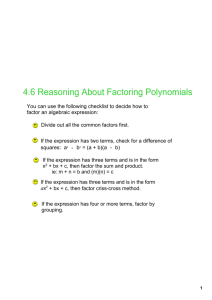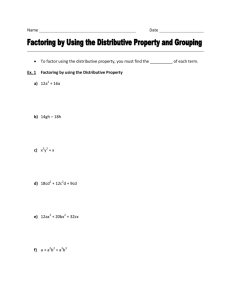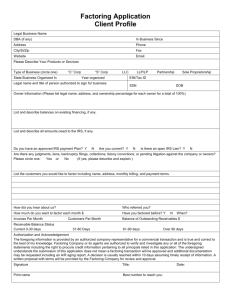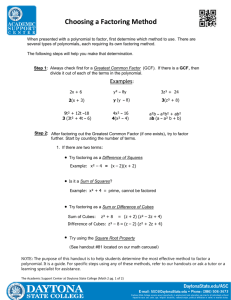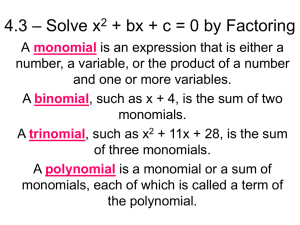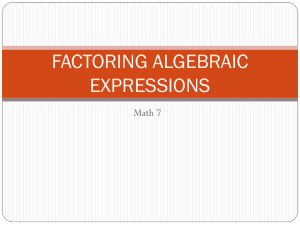Continued Fractions Factoring method
advertisement
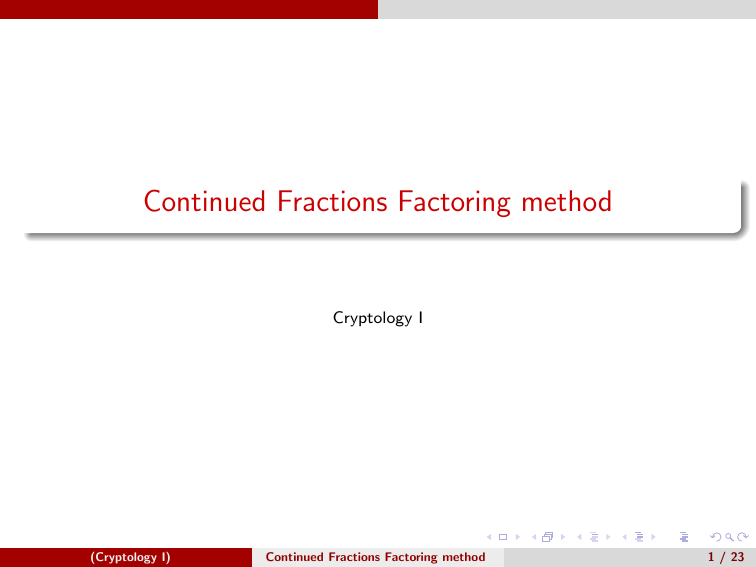
Continued Fractions Factoring method Cryptology I (Cryptology I) Continued Fractions Factoring method 1 / 23 Factoring Trial division Is there a good algorithm for factoring a given integer n? (Cryptology I) Continued Fractions Factoring method 2 / 23 Factoring Trial division Is there a good algorithm for factoring a given integer n? Let n be a number which is a product of two 50 digit prime numbers. (Cryptology I) Continued Fractions Factoring method 2 / 23 Factoring Trial division Is there a good algorithm for factoring a given integer n? Let n be a number which is a product of two 50 digit prime numbers. We need approximately 1050 steps of trial division. (Cryptology I) Continued Fractions Factoring method 2 / 23 Factoring Trial division Is there a good algorithm for factoring a given integer n? Let n be a number which is a product of two 50 digit prime numbers. We need approximately 1050 steps of trial division. Assume that every step takes 10−10 seconds. (Cryptology I) Continued Fractions Factoring method 2 / 23 Factoring Trial division Is there a good algorithm for factoring a given integer n? Let n be a number which is a product of two 50 digit prime numbers. We need approximately 1050 steps of trial division. Assume that every step takes 10−10 seconds. We need to wait for 1040 seconds (∼ 1032 years). (Cryptology I) Continued Fractions Factoring method 2 / 23 Factoring RSA Factoring Challenge The RSA Challenge problem is the problem of finding the factorization of the RSA modulus n. 1 2 B.Dixon & A.Lenstra, “Factoring integers using SIMD sieves” (1994) A.Lenstra et al., “ Factoring RSA-768”, (2009) (Cryptology I) Continued Fractions Factoring method 3 / 23 Factoring RSA Factoring Challenge The RSA Challenge problem is the problem of finding the factorization of the RSA modulus n. RSA-100: 15226050279225333605356183781326374297180681149613 80688657908494580122963258952897654000350692006139 1 2 B.Dixon & A.Lenstra, “Factoring integers using SIMD sieves” (1994) A.Lenstra et al., “ Factoring RSA-768”, (2009) (Cryptology I) Continued Fractions Factoring method 3 / 23 Factoring RSA Factoring Challenge The RSA Challenge problem is the problem of finding the factorization of the RSA modulus n. RSA-100: 15226050279225333605356183781326374297180681149613 80688657908494580122963258952897654000350692006139 1 RSA-768: 1230186684530117755130494958384962720772853569595334 7921973224521517264005072636575187452021997864693899 5647494277406384592519255732630345373154826850791702 6122142913461670429214311602221240479274737794080665 351419597459856902143413 2 1 2 B.Dixon & A.Lenstra, “Factoring integers using SIMD sieves” (1994) A.Lenstra et al., “ Factoring RSA-768”, (2009) (Cryptology I) Continued Fractions Factoring method 3 / 23 Factoring RSA Factoring Challenge The RSA Challenge problem is the problem of finding the factorization of the RSA modulus n. RSA-100: 15226050279225333605356183781326374297180681149613 80688657908494580122963258952897654000350692006139 1 RSA-768: 1230186684530117755130494958384962720772853569595334 7921973224521517264005072636575187452021997864693899 5647494277406384592519255732630345373154826850791702 6122142913461670429214311602221240479274737794080665 351419597459856902143413 2 1 2 B.Dixon & A.Lenstra, “Factoring integers using SIMD sieves” (1994) A.Lenstra et al., “ Factoring RSA-768”, (2009) (Cryptology I) Continued Fractions Factoring method 3 / 23 Continued Fractions Continued Fractions An expression of the form b1 x = a0 + (1) b2 a1 + a2 ... + bn−1 an−1 + bn an is called a continued fraction. It is called simple continued fraction if all the bi ’s are 1 and all the ai ’s are integers such that a1 , a2 , ... ≥ 1. (Cryptology I) Continued Fractions Factoring method 4 / 23 Continued Fractions Continued Fractions We can denote the simple continued fraction with 1 [a1 , a2 , ..., an ] = a0 + 1 a1 + 1 a2 ... + 1 an−1 + an Ck = [a1 , a2 , ..., ak ] for k ≤ n is called k-th convergent of the simple continued fraction. (Cryptology I) Continued Fractions Factoring method 5 / 23 Continued Fractions Infinite Continued fractions The infinite continued fraction, [a1 , a2 , ..., ak , ...] is defined as a limit of the convergents Ck = [a1 , a2 , ..., ak ]. Theorem Every real number can be expressed as a continued fraction. (Cryptology I) Continued Fractions Factoring method 6 / 23 Continued Fractions Infinite Continued fractions The infinite continued fraction, [a1 , a2 , ..., ak , ...] is defined as a limit of the convergents Ck = [a1 , a2 , ..., ak ]. Theorem Every real number can be expressed as a continued fraction. Theorem Suppose that pk /qk is the k-th convergent of (Cryptology I) √ n. Then Continued Fractions Factoring method 6 / 23 Continued Fractions Infinite Continued fractions The infinite continued fraction, [a1 , a2 , ..., ak , ...] is defined as a limit of the convergents Ck = [a1 , a2 , ..., ak ]. Theorem Every real number can be expressed as a continued fraction. Theorem Suppose that pk /qk is the k-th convergent of √ n. Then pk2 − nqk2 = (−1)k+1 Bk+1 . (Cryptology I) Continued Fractions Factoring method 6 / 23 Continued Fractions Continued Fraction Method CFRAC 3 3 M.A. Morrison and J. Brillhart, “A method of factoring and Factorization of F7 ”, (1975) (Cryptology I) Continued Fractions Factoring method 7 / 23 Continued Fractions Continued Fraction Method CFRAC 3 Successfully factored F7 = 2128 + 1. 3 M.A. Morrison and J. Brillhart, “A method of factoring and Factorization of F7 ”, (1975) (Cryptology I) Continued Fractions Factoring method 7 / 23 Continued Fractions Continued Fraction Method CFRAC 3 Successfully factored F7 = 2128 + 1. First method with subexponential running time. 3 M.A. Morrison and J. Brillhart, “A method of factoring and Factorization of F7 ”, (1975) (Cryptology I) Continued Fractions Factoring method 7 / 23 Continued Fractions Continued Fraction Method CFRAC 3 Successfully factored F7 = 2128 + 1. First method with subexponential running time. Most efficient general factorization method. 3 M.A. Morrison and J. Brillhart, “A method of factoring and Factorization of F7 ”, (1975) (Cryptology I) Continued Fractions Factoring method 7 / 23 Continued Fractions Continued Fraction Method CFRAC 3 Successfully factored F7 = 2128 + 1. First method with subexponential running time. Most efficient general factorization method. Main factoring method in use during 1970-1985. 3 M.A. Morrison and J. Brillhart, “A method of factoring and Factorization of F7 ”, (1975) (Cryptology I) Continued Fractions Factoring method 7 / 23 Continued Fractions Continued Fraction Method CFRAC 3 Successfully factored F7 = 2128 + 1. First method with subexponential running time. Most efficient general factorization method. Main factoring method in use during 1970-1985. Foundation for QS and NFS factoring methods. 3 M.A. Morrison and J. Brillhart, “A method of factoring and Factorization of F7 ”, (1975) (Cryptology I) Continued Fractions Factoring method 7 / 23 CFRAC factoring method Gaussian Elimination Gaussian elimination is an efficient algorithm for solving system of linear equations. where x1 , x2 , ..., xn are the unknown variable, a11 , a12 , ..., amn are the coefficients of the system, and b1 , b2 , ..., bm are the constant terms. (Cryptology I) Continued Fractions Factoring method 8 / 23 CFRAC factoring method Gaussian Elimination The system of linear equations is equivalent to a matrix equation of the form A·x=b where A is an m × n matrix, x is a column vector with n entries, and b is a column vector with m entries. (Cryptology I) Continued Fractions Factoring method 9 / 23 CFRAC factoring method Gaussian Elimination-Example We have the following system of equations 4 4 http://www.sosmath.com (Cryptology I) Continued Fractions Factoring method 10 / 23 CFRAC factoring method Gaussian Elimination-Example We have the following system of equations 4 The corresponding matrix equation is 4 http://www.sosmath.com (Cryptology I) Continued Fractions Factoring method 10 / 23 CFRAC factoring method Gaussian Elimination-Example 5 We use elementary row operations to transform this matrix into a triangular one. We keep the first row and use it to produce all zeros elsewhere in the first column. We have 5 http://www.sosmath.com (Cryptology I) Continued Fractions Factoring method 11 / 23 CFRAC factoring method Gaussian Elimination-Example 5 We use elementary row operations to transform this matrix into a triangular one. We keep the first row and use it to produce all zeros elsewhere in the first column. We have Continuing like this we get the following triangular matrix 5 http://www.sosmath.com (Cryptology I) Continued Fractions Factoring method 11 / 23 CFRAC factoring method Legendre function Definition Let 0 < a < n. We say that a is a quadratic residue of n if there is and x such that x 2 mod n = a. (Cryptology I) Continued Fractions Factoring method 12 / 23 CFRAC factoring method Legendre function Definition Let 0 < a < n. We say that a is a quadratic residue of n if there is and x such that x 2 mod n = a. Definition Let p be a prime and a < p a positive integer. The Legendre symbol is a multiplicative function with values 1, -1, 0 that is a quadratic character modulo a prime number p: its value on a quadratic residue mod p is 1 and on a non-quadratic residue is -1. (Cryptology I) Continued Fractions Factoring method 12 / 23 CFRAC factoring method Fermat’s Theorem Theorem If x 2 ≡ y 2 mod n and x 6≡ ±y mod n, then either gcd(x + y , n) or gcd(x − y , n) is a proper factor of n. (Cryptology I) Continued Fractions Factoring method 13 / 23 CFRAC factoring method CFRAC factoring method Theorem Suppose that pk /qk is the k-th convergent of (Cryptology I) √ n. Then Continued Fractions Factoring method 14 / 23 CFRAC factoring method CFRAC factoring method Theorem Suppose that pk /qk is the k-th convergent of √ n. Then pk2 − nqk2 = (−1)k+1 Bk+1 . (Cryptology I) Continued Fractions Factoring method 14 / 23 CFRAC factoring method CFRAC factoring method Theorem Suppose that pk /qk is the k-th convergent of √ n. Then pk2 − nqk2 = (−1)k+1 Bk+1 . The theorem implies that pk2 = (−1)k+1 Bk+1 mod n (Cryptology I) Continued Fractions Factoring method 14 / 23 CFRAC factoring method CFRAC factoring method Theorem Suppose that pk /qk is the k-th convergent of √ n. Then pk2 − nqk2 = (−1)k+1 Bk+1 . The theorem implies that pk2 = (−1)k+1 Bk+1 mod n To apply the Fermat theorem we need squares on both sides. (Cryptology I) Continued Fractions Factoring method 14 / 23 CFRAC factoring method CFRAC factoring method Theorem Suppose that pk /qk is the k-th convergent of √ n. Then pk2 − nqk2 = (−1)k+1 Bk+1 . The theorem implies that pk2 = (−1)k+1 Bk+1 mod n To apply the Fermat theorem we need squares on both sides. The idea of continued fractions is to generate pairs (pk , Bk+1 ) and take suitable combinations to produce a square on the right and to possibly factor n. (Cryptology I) Continued Fractions Factoring method 14 / 23 CFRAC factoring method CFRAC factoring method Theorem Suppose that pk /qk is the k-th convergent of √ n. Then pk2 − nqk2 = (−1)k+1 Bk+1 . The theorem implies that pk2 = (−1)k+1 Bk+1 mod n To apply the Fermat theorem we need squares on both sides. The idea of continued fractions is to generate pairs (pk , Bk+1 ) and take suitable combinations to produce a square on the right and to possibly factor n. Recall that the integer is a perfect square if and only the exponents in the prime factorization are all even. (Cryptology I) Continued Fractions Factoring method 14 / 23 CFRAC factoring method CFRAC factoring method Theorem Suppose that pk /qk is the k-th convergent of √ n. Then pk2 − nqk2 = (−1)k+1 Bk+1 . The theorem implies that pk2 = (−1)k+1 Bk+1 mod n To apply the Fermat theorem we need squares on both sides. The idea of continued fractions is to generate pairs (pk , Bk+1 ) and take suitable combinations to produce a square on the right and to possibly factor n. Recall that the integer is a perfect square if and only the exponents in the prime factorization are all even. Thus, to find the products of Bk ’s that yield perfect square we obtain their prime factorization and combine them so that the exponents become even. (Cryptology I) Continued Fractions Factoring method 14 / 23 CFRAC factoring method CFRAC factoring method Theorem Suppose that pk /qk is the k-th convergent of √ n. Then pk2 − nqk2 = (−1)k+1 Bk+1 . The theorem implies that pk2 = (−1)k+1 Bk+1 mod n To apply the Fermat theorem we need squares on both sides. The idea of continued fractions is to generate pairs (pk , Bk+1 ) and take suitable combinations to produce a square on the right and to possibly factor n. Recall that the integer is a perfect square if and only the exponents in the prime factorization are all even. Thus, to find the products of Bk ’s that yield perfect square we obtain their prime factorization and combine them so that the exponents become even. The factorization of Bk is obtained by trial division. (Cryptology I) Continued Fractions Factoring method 14 / 23 CFRAC factoring method CFRAC factoring method Select a set of primes over which Bk factors. If p|Bk we have pk = nqk2 mod p (Cryptology I) Continued Fractions Factoring method 15 / 23 CFRAC factoring method CFRAC factoring method Select a set of primes over which Bk factors. If p|Bk we have pk = nqk2 mod p So n is a quadratic residue modulo p. Select a set of primes q such that legendre(n, q) = 1. This set of primes is called a factor base. (Cryptology I) Continued Fractions Factoring method 15 / 23 CFRAC factoring method CFRAC example Table: Integer: n = 4141, Factor base: 2, 3, 5, 7, 11 go to this page (Cryptology I) k +1 pk Bk+1 Bk+1 factored 2 3 6 8 11 12 13 14 15 17 18 19 20 129 193 814 3719 2266 3463 232 2570 2367 3959 3436 3254 3142 77 20 36 21 84 33 9 5 84 4 105 21 20 71 111 22 51 22 32 31 71 22 31 71 31 111 32 51 2 2 31 71 22 1 3 51 71 31 71 22 51 Continued Fractions Factoring method go to this page 16 / 23 CFRAC factoring method CFRAC factoring method Remark: We have to include −1 as an element in the factor base to take into account the negative sign when k + 1 is odd. In general, suppose we have the factorization of Bk ’s: B1 = p1a11 p2a12 ...pra1r . . . as1 as2 Bs = p1 p2 ...prasr where p1 , p2 , ..., ps are the primes of the factor base with p1 = −1. (Cryptology I) Continued Fractions Factoring method 17 / 23 CFRAC factoring method CFRAC factoring method We need to find numbers e1 , e2 , ..., es that are either 0 or 1 such that B1e1 B2e2 ...Bses is a perfect square. (Cryptology I) Continued Fractions Factoring method 18 / 23 CFRAC factoring method CFRAC factoring method We need to find numbers e1 , e2 , ..., es that are either 0 or 1 such that B1e1 B2e2 ...Bses is a perfect square. (Cryptology I) Continued Fractions Factoring method 18 / 23 CFRAC factoring method CFRAC factoring method We need to find numbers e1 , e2 , ..., es that are either 0 or 1 such that B1e1 B2e2 ...Bses is a perfect square. B1e1 B2e2 ...Bses = (p1a11 p2a21 ...pkak1 )e1 · ... · (p1a1s p2a2s ...pkaks )es = (Cryptology I) Continued Fractions Factoring method 18 / 23 CFRAC factoring method CFRAC factoring method We need to find numbers e1 , e2 , ..., es that are either 0 or 1 such that B1e1 B2e2 ...Bses is a perfect square. B1e1 B2e2 ...Bses = (p1a11 p2a21 ...pkak1 )e1 · ... · (p1a1s p2a2s ...pkaks )es = = p1a11 e1 +a12 e2 +...+a1s es · ... · pkak1 e1 +ak2 e2 +...+aks es (Cryptology I) Continued Fractions Factoring method 18 / 23 CFRAC factoring method CFRAC factoring method We need to find numbers e1 , e2 , ..., es that are either 0 or 1 such that B1e1 B2e2 ...Bses is a perfect square. B1e1 B2e2 ...Bses = (p1a11 p2a21 ...pkak1 )e1 · ... · (p1a1s p2a2s ...pkaks )es = = p1a11 e1 +a12 e2 +...+a1s es · ... · pkak1 e1 +ak2 e2 +...+aks es We need to find e1 , e2 , ..., es such that e1 a1i + e2 a2i + ... + es asi is even for all i. (Cryptology I) Continued Fractions Factoring method 18 / 23 CFRAC factoring method CFRAC factoring method We need to solve the system of linear equation a11 e1 + a12 e2 + ... + a1s es = 0 mod 2 a21 e1 + a22 e2 + ... + a2s es = 0 mod 2 ··· ak1 e1 + ak2 e2 + ... + aks es = 0 mod 2 i.e. to solve the matrix equation Ae = 0, where e = (e1 , e2 , ..., es ) and A is the matrix whose ij-th entry is aij . (Cryptology I) Continued Fractions Factoring method 19 / 23 CFRAC factoring method CFRAC factoring method We need to solve the system of linear equation a11 e1 + a12 e2 + ... + a1s es = 0 mod 2 a21 e1 + a22 e2 + ... + a2s es = 0 mod 2 ··· ak1 e1 + ak2 e2 + ... + aks es = 0 mod 2 i.e. to solve the matrix equation Ae = 0, where e = (e1 , e2 , ..., es ) and A is the matrix whose ij-th entry is aij . The equation Ae = 0 can be solved By Gaussian elimination modulo 2. (Cryptology I) Continued Fractions Factoring method 19 / 23 CFRAC factoring method CFRAC factoring method We need to solve the system of linear equation a11 e1 + a12 e2 + ... + a1s es = 0 mod 2 a21 e1 + a22 e2 + ... + a2s es = 0 mod 2 ··· ak1 e1 + ak2 e2 + ... + aks es = 0 mod 2 i.e. to solve the matrix equation Ae = 0, where e = (e1 , e2 , ..., es ) and A is the matrix whose ij-th entry is aij . The equation Ae = 0 can be solved By Gaussian elimination modulo 2. If s > r then we are guaranteed a nontrivial solution. (Cryptology I) Continued Fractions Factoring method 19 / 23 CFRAC factoring method Matrix of exponents modulo 2 for n = 4141 −1 2 3 5 7 11 0 0 0 0 1 1 A = 1 0 0 1 0 0 0 0 0 0 0 0 1 0 0 1 0 1 0 1 1 0 0 0 0 0 0 0 1 0 1 0 1 0 1 1 0 0 0 0 0 0 1 1 1 1 0 1 0 1 0 0 0 1 0 0 0 1 0 0 0 0 0 0 0 0 example (Cryptology I) Continued Fractions Factoring method 20 / 23 CFRAC factoring method CFRAC factoring method The solutions yield combinations that will produce pi21 pi22 ...pi2k = Bi1 +1 Bi2 +1 ...Bik +1 mod n (Cryptology I) Continued Fractions Factoring method 21 / 23 CFRAC factoring method CFRAC factoring method The solutions yield combinations that will produce pi21 pi22 ...pi2k = Bi1 +1 Bi2 +1 ...Bik +1 mod n where the expression Bi1 +1 Bi2 +1 ...Bik +1 is a square. (Cryptology I) Continued Fractions Factoring method 21 / 23 CFRAC factoring method CFRAC factoring method The solutions yield combinations that will produce pi21 pi22 ...pi2k = Bi1 +1 Bi2 +1 ...Bik +1 mod n where the expression Bi1 +1 Bi2 +1 ...Bik +1 is a square. It is possible that such combination does not yield a proper factor of n. (Cryptology I) Continued Fractions Factoring method 21 / 23 CFRAC factoring method CFRAC factoring method-Example example Computing gcd’s: (Cryptology I) Continued Fractions Factoring method 22 / 23 CFRAC factoring method CFRAC factoring method-Example example Computing gcd’s: gcd(193 · 3719 · 2266 · 3142 − 20 · 3 · 2 · 7, n) = 4141 (Cryptology I) Continued Fractions Factoring method 22 / 23 CFRAC factoring method CFRAC factoring method-Example example Computing gcd’s: gcd(193 · 3719 · 2266 · 3142 − 20 · 3 · 2 · 7, n) = 4141 gcd(193 · 3719 · 2266 · 3142 − 20 · 3 · 2 · 7, n) = 1 (Cryptology I) Continued Fractions Factoring method 22 / 23 CFRAC factoring method CFRAC factoring method-Example example Computing gcd’s: gcd(193 · 3719 · 2266 · 3142 − 20 · 3 · 2 · 7, n) = 4141 gcd(193 · 3719 · 2266 · 3142 − 20 · 3 · 2 · 7, n) = 1 gcd(2266 · 3254 − 2 · 3 · 7, n) = 41 (Cryptology I) Continued Fractions Factoring method 22 / 23 CFRAC factoring method CFRAC factoring method-Example example Computing gcd’s: gcd(193 · 3719 · 2266 · 3142 − 20 · 3 · 2 · 7, n) = 4141 gcd(193 · 3719 · 2266 · 3142 − 20 · 3 · 2 · 7, n) = 1 gcd(2266 · 3254 − 2 · 3 · 7, n) = 41 gcd(2266 · 3254 + 2 · 3 · 7, n) = 101 (Cryptology I) Continued Fractions Factoring method 22 / 23 CFRAC factoring method The CFRAC method √ √ Step 1 Expand n (or cn) into a simple continued fraction expansion to √ some point m i.e. n = [a0 , a1 , a2 , ..., am ]. (Cryptology I) Continued Fractions Factoring method 23 / 23 CFRAC factoring method The CFRAC method √ √ Step 1 Expand n (or cn) into a simple continued fraction expansion to √ some point m i.e. n = [a0 , a1 , a2 , ..., am ]. Step 2 Generate “pk − Bk pairs”. (Cryptology I) Continued Fractions Factoring method 23 / 23 CFRAC factoring method The CFRAC method √ √ Step 1 Expand n (or cn) into a simple continued fraction expansion to √ some point m i.e. n = [a0 , a1 , a2 , ..., am ]. Step 2 Generate “pk − Bk pairs”. Step 3 Find among the set of “pk − Bk pairs” generated in the previous step certain subsets (called “ S-sets”) each having the property that the Q product i (−1)i Bi of its Bi ’s is a square. (Cryptology I) Continued Fractions Factoring method 23 / 23 CFRAC factoring method The CFRAC method √ √ Step 1 Expand n (or cn) into a simple continued fraction expansion to √ some point m i.e. n = [a0 , a1 , a2 , ..., am ]. Step 2 Generate “pk − Bk pairs”. Step 3 Find among the set of “pk − Bk pairs” generated in the previous step certain subsets (called “ S-sets”) each having the property that the Q product i (−1)i Bi of its Bi ’s is a square. If no such set is found go √ to Step 1 and expand n. (Cryptology I) Continued Fractions Factoring method 23 / 23 CFRAC factoring method The CFRAC method √ √ Step 1 Expand n (or cn) into a simple continued fraction expansion to √ some point m i.e. n = [a0 , a1 , a2 , ..., am ]. Step 2 Generate “pk − Bk pairs”. Step 3 Find among the set of “pk − Bk pairs” generated in the previous step certain subsets (called “ S-sets”) each having the property that the Q product i (−1)i Bi of its Bi ’s is a square. If no such set is found go √ to Step 1 and expand n. Step 4 Each S-set 3 gives rise to the congruence Q found Q in Step 2 i X ≡ i pi ≡ i (−1) Bi = Y 2 mod n, where 1 ≤ X < n. (Cryptology I) Continued Fractions Factoring method 23 / 23 CFRAC factoring method The CFRAC method √ √ Step 1 Expand n (or cn) into a simple continued fraction expansion to √ some point m i.e. n = [a0 , a1 , a2 , ..., am ]. Step 2 Generate “pk − Bk pairs”. Step 3 Find among the set of “pk − Bk pairs” generated in the previous step certain subsets (called “ S-sets”) each having the property that the Q product i (−1)i Bi of its Bi ’s is a square. If no such set is found go √ to Step 1 and expand n. Step 4 Each S-set 3 gives rise to the congruence Q found Q in Step 2 i X ≡ i pi ≡ i (−1) Bi = Y 2 mod n, where 1 ≤ X < n. Step 5 Compute Y and the gcd(X − Y , n) = d for the S-sets produced in Step 4. If 1 < d < n for some S-set, the method succeeds and d is non-trivial factor of n. Otherwise, return to Step 1. (Cryptology I) Continued Fractions Factoring method 23 / 23 CFRAC factoring method The CFRAC method √ √ Step 1 Expand n (or cn) into a simple continued fraction expansion to √ some point m i.e. n = [a0 , a1 , a2 , ..., am ]. Step 2 Generate “pk − Bk pairs”. Step 3 Find among the set of “pk − Bk pairs” generated in the previous step certain subsets (called “ S-sets”) each having the property that the Q product i (−1)i Bi of its Bi ’s is a square. If no such set is found go √ to Step 1 and expand n. Step 4 Each S-set 3 gives rise to the congruence Q found Q in Step 2 i X ≡ i pi ≡ i (−1) Bi = Y 2 mod n, where 1 ≤ X < n. Step 5 Compute Y and the gcd(X − Y , n) = d for the S-sets produced in Step 4. If 1 < d < n for some S-set, the method succeeds and d is non-trivial factor of n. Otherwise, return to Step 1. (Cryptology I) Continued Fractions Factoring method 23 / 23
